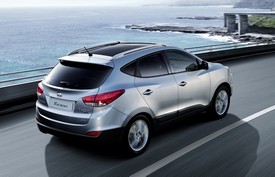Hyundai Tucson LM: Owners and Service manuals

In 2010, a revolutionary new Hyundai Tucson joins the rapidly evolving Hyundai product line. The sleek crossover from Hyundai, with its athletic European design, strikes a stark contrast from its predecessor and improves in every functional area, from its roomier cabin with extra cargo space to its leap in fuel economy and technology. Hyundai Tucson features the company's "Fluidic Sculpture" design language and is the first vehicle in Hyundai's 24/7 version 2.0 product initiative
Key attributes of Hyundai's Fluidic Sculpture design philosophy are the athleticism and sophistication that Hyundai Tucson demonstrates through its flowing lines, full surfaces and muscular presence. This athletic design language is highlighted by bold, dynamic graphic elements such as the new Hyundai family hexagonal front grille, aggressive lower air intake, sculptured hood creases, swept back headlights, sleek greenhouse and wraparound taillights. Chrome grille accents and door handles lend sophistication to the top-of-the-line Tucson Limited.
Hyundai Tucson (LM) 2010-2015 Service Manual
- General Information
- Engine Mechanical System
- Engine Electrical System
- Emission Control System
- Engine Control / Fuel System
- Clutch System
- Manual Transaxle System
- Automatic Transaxle System
- 4 Wheel Drive (4WD) System
- Driveshaft and axle
- Suspension System
- Steering System
- Restraint
- Brake System
- Body (Interior and Exterior)
- Body Electrical System
- Heating, Ventilation and Air Conditioning
